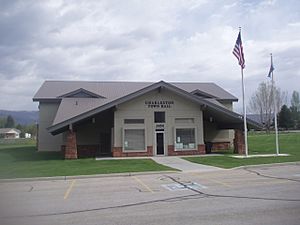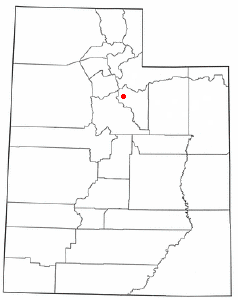Charleston, Utah facts for kids
Quick facts for kids
Charleston, Utah
|
|
|---|---|

Charleston Town Hall
|
|

Location of Charleston, Utah
|
|
| Country | United States |
| State | Utah |
| County | Wasatch |
| Settled | 1858 |
| Founded by | Aaron Daniels |
| Named for | Charles Shelton |
| Area | |
| • Total | 3.07 sq mi (7.95 km2) |
| • Land | 2.86 sq mi (7.41 km2) |
| • Water | 0.21 sq mi (0.54 km2) |
| Elevation | 5,489 ft (1,673 m) |
| Population
(2010)
|
|
| • Total | 415 |
| • Density | 170.10/sq mi (65.68/km2) |
| Time zone | UTC-7 (Mountain (MST)) |
| • Summer (DST) | UTC-6 (MDT) |
| ZIP code |
84032
|
| Area code(s) | 435 |
| FIPS code | 49-12420 |
| GNIS feature ID | 2413190 |
Charleston is a small town located in Wasatch County, Utah, in the United States. It's a quiet place with a population of 436 people, according to the 2020 census. The town was named after Charles Shelton, who was one of its very first settlers.
Contents
About Charleston, Utah
Charleston is a charming town in Utah, known for its peaceful setting. It's a great example of a small American community. The town is located in a beautiful part of Utah, surrounded by nature.
Where is Charleston?
Charleston is found in Wasatch County, Utah. The town covers an area of about 1.9 square miles (4.9 square kilometers). Most of this area is land, but about 0.2 square miles (0.5 square kilometers) is water. This water area likely includes parts of the Provo River or other small bodies of water nearby.
History of Charleston
The story of Charleston began in the mid-1800s. It started as a place where people settled and built new lives.
Early Settlers
In 1858, a trapper named Aaron Daniels was the first to move to this area. He settled near the Provo River, just north of where Charleston is today. The very first farmers started planting crops in Charleston in 1859. Later that year, George Noakes and William Manning built the first houses. They settled near a place called Noakes springs.
Growing Community
For a few years, Noakes and Manning were the only people living there. But by 1863, more families began to arrive. By 1866, about a dozen families called Charleston home. After that, the town's population started to grow much faster.
Community Leadership
George Noakes was an important leader in the early community. He was the first "Presiding Elder" in Charleston, which is a local religious leader. For a while, the Charleston community was part of a larger group called the Heber Ward. In July 1877, Charleston formed its own group, the Charleston Ward. Nymphus C. Murdock became its first "bishop," another type of religious leader. By 1930, the Charleston Ward had 397 members.
Population Changes
The number of people living in Charleston has changed over the years. Here's a look at how the population has grown and shrunk:
| Historical population | |||
|---|---|---|---|
| Census | Pop. | %± | |
| 1880 | 246 | — | |
| 1890 | 501 | 103.7% | |
| 1900 | 490 | −2.2% | |
| 1910 | 524 | 6.9% | |
| 1920 | 361 | −31.1% | |
| 1930 | 343 | −5.0% | |
| 1940 | 323 | −5.8% | |
| 1950 | 201 | −37.8% | |
| 1960 | 223 | 10.9% | |
| 1970 | 196 | −12.1% | |
| 1980 | 320 | 63.3% | |
| 1990 | 336 | 5.0% | |
| 2000 | 378 | 12.5% | |
| 2010 | 415 | 9.8% | |
| 2019 (est.) | 487 | 17.3% | |
| U.S. Decennial Census | |||
Who Lives in Charleston?
In the year 2000, there were 378 people living in Charleston. These people made up 120 households, with 101 of them being families. The town had about 225 people per square mile.
Many households in Charleston had children. About 48% of households had kids under 18 living with them. Most families were married couples living together. The average household had about 3 people, and the average family had almost 3.5 people.
The population in 2000 was spread across different age groups. About 34% of the people were under 18 years old. About 11% were 65 years or older. The average age in Charleston was 37 years.
See also
 In Spanish: Charleston (Utah) para niños
In Spanish: Charleston (Utah) para niños

